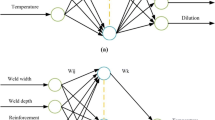Abstract
The single weld bead geometry has critical effects on the layer thickness, surface quality, and dimensional accuracy of metallic parts in layered deposition process. The present study highlights application of a neural network and a second-order regression analysis for predicting bead geometry in robotic gas metal arc welding for rapid manufacturing. A series of experiments were carried out by applying a central composite rotatable design. The results demonstrate that not only the proposed models can predict the bead width and height with reasonable accuracy, but also the neural network model has a better performance than the second-order regression model due to its great capacity of approximating any nonlinear processes. The neural network model can efficiently be used to predict the desired bead geometry with high precision for the adaptive slicing principle in layer additive manufacturing.
Similar content being viewed by others
References
Chokkalingham, S., Chandrasekhar, N., & Vasudevan, M. (2011). Predicting the depth of penetration and weld bead width from the infra red thermal image of the weld pool using artificial neural network modeling. Journal of Intelligent Manufacturing. doi:10.1007/s10845-011-0526-4.
Davies O. L. (1978) The design and analysis of industrial experiments. Longmen, New York
Demuth H., Beale M. (1998) Neural network toolbox-for use with MATLAB. The Math Works Inc, Natick, MA
Doumanidis C., Kwak Y. M. (2002) Multivariable adaptive control of the bead profile geometry in gas metal arc welding with thermal scanning. International Journal of Pressure Vessels and Piping 79: 251–262
Huang W., Kovacevic R. (2011) A neural network and multiple regression method for the characterization of the depth of weld penetration in laser welding based on acoustic signatures. Journal of Intelligent Manufacturing 22: 131–143
Kannan T., Yoganandh J. (2010) Effect of process parameters on clad bead geometry and its shape relationships of stainless steel claddings deposited by GMAW. Internal Journal of Advanced Manufacturing Technology 47: 1083–1095
Karunakaran K.P., Suryakumar S., Pushpa V., Akula S. (2010) Low cost integration of additive and subtractive processes for hybrid layered manufacturing. Robotics and Computer-Integrated Manufacturing 26: 490–499
Lin, H. L. (2010). The use of the Taguchi method with grey relational analysis and a neural network to optimize a novel GMA welding process. Journal of Intelligent Manufacturing. doi:10.1007/s10845-010-0468-2.
Montgomery D. C. (2003) Design and analysis of experiments. Wiley (Asia), Singapore
Mughal M. P., Fawad H., Mufti R. A. (2006) Three-dimensional finite-element modelling of deformation in weld-based rapid prototyping. Proceedings of the Institution of Mechanical Engineers, Part C: Journal of Mechanical Engineering Science 220(6): 875–885
Murugan N., Gunaraj V. (2005) Prediction and control of weld bead geometry and shape relationships in submerged arc welding of pipes. Journal of Materials Processing Technology 168: 478–487
Nagesh D. S., Datta G. L. (2002) Prediction of weld bead geometry and penetration in shielded metal-arc welding using artificial neural networks. Journal of Materials Processing Technology 123: 303–312
Song Y. A., Park S. (2006) Experimental investigations into rapid prototyping of composites by novel hybrid deposition process. Journal of Materials Processing Technology 171: 35–40
Song Y. A., Parka S., Chae S. W. (2005) 3D welding and milling: Part II-optimization of the 3D welding process using an experimental design approach. International Journal of Machine Tools and Manufacture 45: 1063–1069
Sreenathbabu A., Karunakaran K. P., Amarnath C. (2005) Statistical process design for hybrid adaptive layer manufacturing. Rapid Prototyping Journal 11(4): 235–248
Unocic R. R., DuPont J. N. (2004) Process efficiency measurements in the laser engineered net shaping process. Metallurgical and Materials Transactions B 35B(1): 143–152
Weiss L. E., Prinz F. B., Adams D. A., Siewiorek D. P. (1992) Thermal spray shape deposition. Journal of Thermal Spray Technology 1(13): 231–237
Zhang Y. M., Chen Y., Li P., Male A. T. (2003) Weld deposition-based rapid prototyping a preliminary study. Journal of Materials Processing Technology 135: 347–357
Author information
Authors and Affiliations
Corresponding author
Rights and permissions
About this article
Cite this article
Xiong, J., Zhang, G., Hu, J. et al. Bead geometry prediction for robotic GMAW-based rapid manufacturing through a neural network and a second-order regression analysis. J Intell Manuf 25, 157–163 (2014). https://doi.org/10.1007/s10845-012-0682-1
Received:
Accepted:
Published:
Issue Date:
DOI: https://doi.org/10.1007/s10845-012-0682-1




